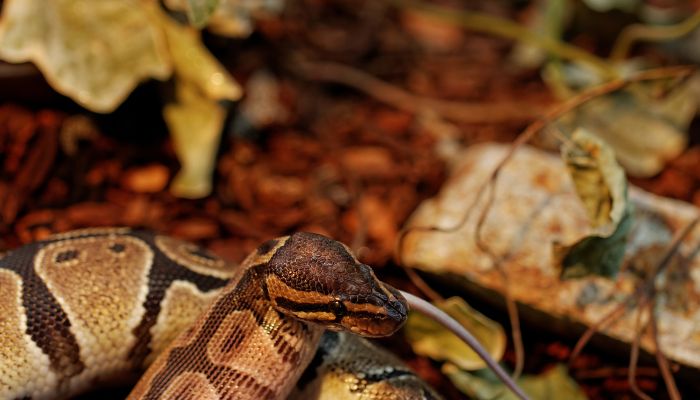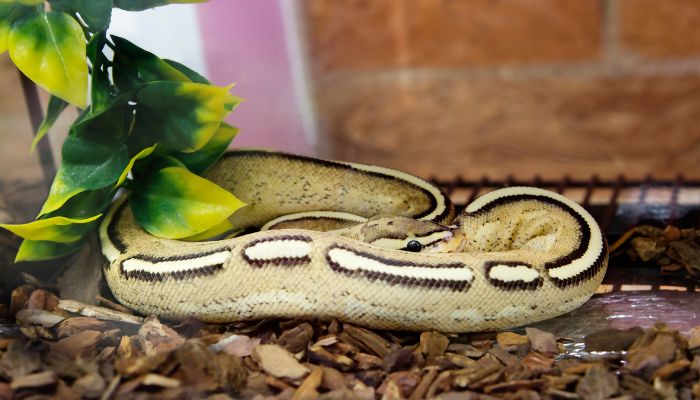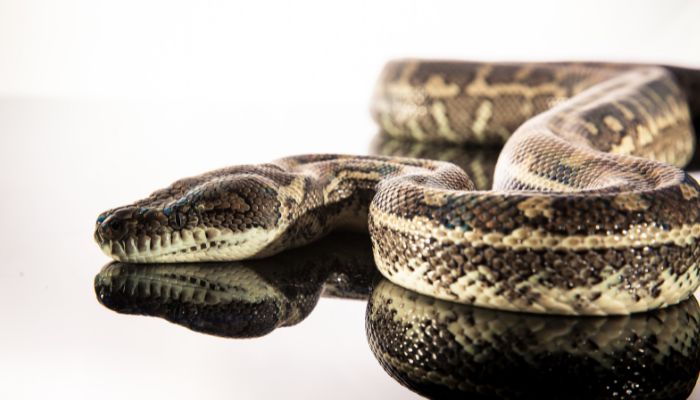Ball Pythons, with their captivating patterns and gentle nature, are a favorite among reptile enthusiasts. But have you ever wondered, “Why do ball pythons burrow?”
Ball pythons burrow primarily for comfort and safety. In the wild, they burrow to regulate body temperature, escaping extreme heat or cold. They also hide from predators. In captivity, burrowing can indicate issues with incorrect temperature or humidity, or signal health concerns.
In this article, we’ll delve deep into the intriguing world of these slithery wonders, exploring their behaviors both in captivity and the wild.
From the crucial roles of temperature and humidity to their natural instincts and health concerns, we’ll uncover the mysteries behind their burrowing habits.
Join us on this journey as we decode the signals and behaviors of Ball Pythons, offering insights and answers to your burning questions.

Table of Contents
Temperature and Its Effects on Burrowing
Ball pythons have a myriad of behaviors that often leave their owners scratching their heads. One such behavior? Burrowing. Well, let’s dive deep into one of the primary reasons: temperature.
The Importance of Tank Temperature
Imagine wearing a winter jacket in the scorching heat of summer. Uncomfortable, right? Similarly, Ball Pythons are extremely sensitive to their environment, especially the temperature.
Their tank temperature plays a pivotal role in their overall well-being. If it’s too hot or too cold, they’ll do whatever they can to find comfort. And often, that means burrowing.
In the wild, these snakes are accustomed to the warm climates of Africa. They’ve evolved to seek out cooler spots during the hottest parts of the day and warmer spots during the cooler nights.
In captivity, if their tank isn’t mimicking this natural temperature gradient, they’ll resort to burrowing to regulate their body temperature.
Effects of High and Low Temperatures on Ball Pythons
High temperatures can be a real stressor for Ball Pythons. When the tank gets too hot, they might start to feel like they’re in a sauna they can’t escape from. This can lead to heat stress, making them seek cooler shelter by burrowing deep into the substrate or hiding under objects.
On the flip side, if the tank’s too cold, it’s like they’re stuck in an endless winter. They might burrow to try and retain some warmth, much like how we snuggle under blankets during cold nights. Low temperatures can slow down their metabolism, making them less active and even affecting their feeding habits.
The Role of Basking Spots and Ambient Temperature
Now, here’s where things get interesting. Ball Pythons love a good sunbath, well, in their own reptilian way. Basking spots in their enclosure allow them to soak up warmth, aiding in digestion and overall health. But, it’s crucial that this basking spot isn’t too hot. It should be a cozy warm spot, not a scalding hotplate.
Ambient temperature, on the other hand, is the overall temperature of the enclosure. It’s essential to maintain a gradient – a warm side and a cool side. This allows the snake to move between areas, thermoregulating their body temperature as needed.
If this gradient is off, you’ll likely find your Ball Python playing hide and seek, burrowing to find that ‘just right’ spot.

The Role of Humidity in Burrowing
Ah, humidity! It’s not just about how it makes our hair frizz up on those muggy days. For Ball Pythons, humidity plays a pivotal role in their daily life, especially when it comes to burrowing. Let’s unravel this moisture mystery, shall we?
How Low Humidity Affects Shedding
Imagine your skin feeling super dry, almost to the point of cracking. Unpleasant, right? Ball Pythons feel a similar discomfort when the humidity in their enclosure is too low. This becomes especially problematic during their shedding phase.
Without adequate humidity, they can face difficulties in shedding their skin completely, leading to what herpetologists call “retained shed.” This can be particularly troublesome around sensitive areas like their eyes.
And guess what they might do to counteract this? Yep, burrow! By burrowing, they seek out the dampest parts of their enclosure to aid in the shedding process.
The Significance of 60-80% Humidity for Ball Pythons
Ball Pythons hail from the subtropical regions of Africa, where humidity levels are consistently high. For these reptiles, a humidity level of 60-80% is the sweet spot. It mimics their natural habitat, ensuring their skin remains supple and aiding in smooth shedding cycles.
Maintaining this range is crucial for their overall skin health and comfort.
Tips for Maintaining Optimal Humidity
- Misting: A light misting of their enclosure with water can help boost humidity levels. But remember, it’s a fine balance – you don’t want a swamp!
- Water Bowls: Placing a sizable water bowl in the enclosure can aid in maintaining humidity. Plus, it gives them a spot to take a dip!
- Substrate: Using a moisture-retaining substrate like coconut coir or cypress mulch can help maintain consistent humidity levels.
- Hygrometers: Invest in a good hygrometer to keep a check on humidity levels. It’s like a thermostat, but for moisture!

Lack of Appropriate Hide Boxes
Hide boxes, or hides, are more than just decorative pieces in a Ball Python’s enclosure. They’re essential for their well-being. Think of them as a personal sanctuary, a place where they can retreat and feel safe.
Without appropriate hides, Ball Pythons can feel exposed and vulnerable. It’s like being in a vast open field with nowhere to hide. This can be incredibly stressful for them. And when they’re stressed, they’ll look for places to hide, leading them to burrow deep into the substrate.
It’s essential to provide hides that are snug, allowing the Ball Python to fit comfortably without too much extra space. They prefer tight spaces where they can feel the enclosure around their bodies. Think of it as their version of a cozy blanket fort!
Moreover, having multiple hides – one on the warmer side and one on the cooler side of the enclosure – allows them to choose where they want to rest while maintaining their body temperature.

Natural Behavior in the Wild
Let’s take a journey to the vast landscapes of Africa, where Ball Pythons roam free in their natural habitat. It’s a world far removed from the controlled environments of our homes, and understanding their wild behaviors can offer insights into their actions in captivity.
How Ball Pythons Behave in Their Natural Habitat
In the wild, Ball Pythons are masters of stealth and camouflage. They’re not the top of the food chain, so they’ve developed behaviors to stay off the menu. They’re nocturnal, preferring to be active during the cooler, safer nights while resting during the day.
Their Tendency to Burrow
Now, here’s where the digging comes in. Ball Pythons, in their natural setting, often burrow to escape the prying eyes of predators.
These burrows offer them a safe haven, a place where they can lay low and avoid becoming someone’s lunch. Additionally, the African sun can be relentless.
To escape extreme temperatures, especially during the hottest parts of the day, these snakes will burrow into the cooler earth, maintaining a comfortable body temperature. It’s all about survival and comfort out there in the wild!

Health Concerns Leading to Burrowing
Just like us humans, Ball Pythons can have their off days, and sometimes, these are due to health concerns. When they’re not feeling their best, burrowing can be a sign that something’s amiss.
Parasitic Infestations
No one likes uninvited guests, especially if they’re parasites. Mites, for instance, can be a real nuisance for Ball Pythons. These tiny critters can cause itching, discomfort, and even disrupt the shedding process.
To find relief, especially in a damp substrate that might soothe their skin, Ball Pythons may burrow. It’s their way of saying, “I need a break from these pesky pests!”
Other Illnesses
Beyond parasites, other health issues can prompt a Ball Python to burrow. Respiratory infections, scale rot, or even internal diseases can make them feel vulnerable. In the wild, a sick snake is an easy target.
So, by instinct, when they’re feeling under the weather, they might burrow to hide away, seeking safety and comfort until they’re back in tip-top shape.
Always keep an eye out for sudden changes in behavior; it might be their way of signaling that a vet visit is in order!
Conclusion
From temperature and humidity factors to their natural behaviors and health concerns, you’ve gained insights into their unique world.
Remember, these creatures communicate in subtle ways, and burrowing is one of them. As you care for your Ball Python, keep these insights in mind, ensuring they have the best environment possible.
With knowledge and dedication, you’re well on your way to becoming an exceptional reptile guardian. Keep observing, keep learning, and always strive for the best for your slithery friend!
Commonly Asked Questions
Let’s tackle some of the most commonly asked questions about these slithery wonders.
Do Male Ball Pythons Burrow?
Yes, they do! Gender doesn’t play a significant role when it comes to burrowing. Both male and female Ball Pythons can burrow, especially if they’re seeking comfort, safety, or trying to regulate their body temperature.
Why is My Ball Python Suddenly Burrowing?
A sudden change in behavior can be a sign of various factors – maybe the tank’s temperature or humidity is off, or perhaps they’re feeling stressed or unwell. It’s essential to monitor their environment and health to pinpoint the cause.
What Do Ball Pythons Do When Scared?
When frightened, Ball Pythons might curl into a tight ball, hiding their head inside their coils. This behavior is where their name “Ball” Python comes from! They might also seek refuge by burrowing or hiding in their hide boxes.
How Do You Know If Your Snake is Stressed?
Signs of stress in Ball Pythons include excessive hiding, refusal to eat, rapid breathing, or frequent attempts to escape their enclosure. If you notice these signs, it’s crucial to assess their environment and consult with a reptile expert or veterinarian.




0 Comments